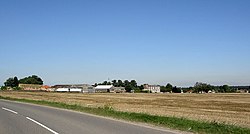Marr, Yorkshire
| Marr | |
| Yorkshire West Riding | |
|---|---|

| |
| Location | |
| Grid reference: | SE518051 |
| Location: | 53°32’31"N, 1°13’30"W |
| Data | |
| Post town: | Doncaster |
| Postcode: | DN5 |
| Dialling code: | 01302 |
| Local Government | |
| Council: | Doncaster |
| Parliamentary constituency: |
Doncaster North |
Marr is a tiny village in the West Riding of Yorkshire, found just west of Junction 37 of the A1(M). It had a population of 138 recorded in 2001.
The village is listed in the Domesday Book of 1086.
About the village
Marr stands on the main road between Barnsley and Doncaster (A635 Barnsley Road) and also 5 minutes drive from the A1(M) junction 37. Marr, although now mainly modern, does have a number of outstanding features; there remains an iron-age barrow at the junction of Barnburgh, Marr and High Melton which can be seen through aerial photographs. Seventy Roman coins were found recently as evidence of the boundary line which Marr formed at Rickneild Street. The Gothic-style church of St Helens has original herringbone masonry, early Norman chancel and nave, 13th/14th century short spire tower, 15th stone-ribbed porch and font and the pulpit has fine mediæval woodwork. The church also contains figures of John Lewis and wife dated from 1579 in Brass and pieces of funeral armour. There are two further buildings of note in the Marr Hall Farm. Parts of the farm buildings are original (1800s) and fairly unique, the Hall itself retains an Elizabethan / Jacobean west side with a semi-circular entrance porch. This building is now the farmhouse and has a Georgian style overall. The farm also maintains over 14 arched openings which would have been used for storage of carts, drays etc. The arches stand on solid stone piers and is thought to be have been designed by Charles Sabine Augustus Thellusson an Italian architect who died in 1885.
The story of how Charles Thellusson (The Landed Gentry, Burke pages 598-600) gained control over the Brodsworth Estate (including the farm) is a saga in itself. The Thellusson family as involved in a long-running feud over inheritance money and Brodsworth Estates belonging originally to Peter Thellusson, a city merchant who died leaving the equivalent of £50 million in trust, which was long fought over in Chancery, in the famed Thellusson Will Case. The money was put aside to gather interest during his own lifetime and the lifetime of his sons and grandsons (who were living at the time of his own death) only to be divided up between his remaining male descendants when the last of his three sons/grandsons died. The will and its subsequent case in the Court of Chancery brought by his family were notorious and may have inspired Charles Dickens to create the fictional case of Jarndyce v Jarndyce which continues throughout his novel Bleak House
References
- The Landed Gentry Burke's
- The Manorial Society of Great Britain